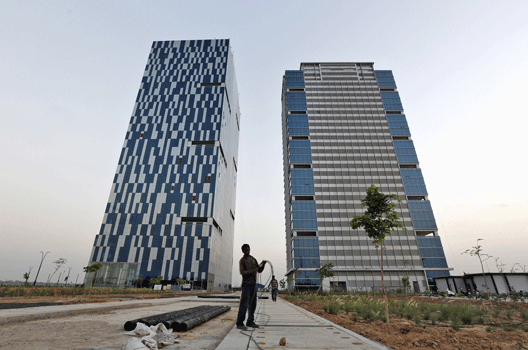 By 2050, 843 million people will be living in urban areas of India. They will migrate from rural regions for better job opportunities, better health care, and a better life. How will cities sustain this huge influx of people?
By 2050, 843 million people will be living in urban areas of India. They will migrate from rural regions for better job opportunities, better health care, and a better life. How will cities sustain this huge influx of people?
The government of India is already addressing this question. With the Smart Cities Mission, it is preparing urban areas to deal with the migration anticipated to occur within the next thirty years. The plan is to equip one hundred cities in India with the best infrastructure in the next five years and then continue to maintain the same pace of development over time. However, most infrastructure projects in India have been delayed in the past due to corruption, bureaucracy, and scarcity of funds. Will the government be able to speed up India’s urban development? The Smart Cities Mission is designed specifically to do so by making efficient use of human capital, land, the manufacturing sector, and technology.
Metropolitan cities in India act as magnets for investment, resulting in better opportunities and greater competition, drawing in people from rural areas. The drawback is that these cities have become overcrowded and the supply of migrant labor is underutilized or wasted. The Smart Cities plan addresses this problem by supporting the creation of “industrial corridors” across the country. These “industrial corridors” will allow manufacturing units to flourish, create jobs, and improve the infrastructure around them, giving rise to smart cities and ensuring that the demand for labor is evenly dispersed throughout the country. The existing burden on cities will reduce and people’s standard of living will improve.
Despite an investment of $1.2 billion in this project, existing government funding will not be enough to sustain it. The central and state governments are adopting new ways of accumulating funds, such as charging parking fees in cities and inviting foreign direct investment in the infrastructure sector. The government’s “Make in India” initiative has not only improved foreign investments but raised the standards of manufacturing in the country. This initiative, combined with the urban development of cities, will create jobs and greater economic growth.
India has always had the labor force and now it also has the capital to fulfill its target of achieving greater economic growth. In order to make the best use of these resources, India has to adopt the best technology. This third factor will ensure that the first two are used most effectively.
Indian Prime Minister Narendra Modi’s government has already envisioned a “Digital India” project that, combined with the Smart Cities plan, will support India’s economic growth. The use of advanced technology in business, transportation, hospitals, and schools will improve efficiency, reduce waste, and increase transparency. This could include the use of smarter machinery in the production of goods that reduces pollution, and digital banking services that not only help increase transparency but reduce transaction time and the use of mobile technology to improve connectivity between people and the government.
Planned urban development in India is long overdue but some continue to think that the Smart Cities Mission might fail because of India’s unpleasant history with infrastructure projects. Delayed completion, weak structures, and lack of funds are some of the causes of slow development. Yet this time the move to improve infrastructure seems to be different. The government has adopted a more inclusive method to develop India and is working collaboratively with the individual states throughout the country, private companies, and the public. It is working toward making the processes transparent and more efficient through the use of technology. The central government is willing to provide the resources while the implementation of the new technology is expected from the state governments and private organizations. The government is not engaging in a one-sided conversation but in an interactive exchange of ideas to achieve the Smart Cities Mission.
With India’s urban population expected to grow to 843 million in the next thirty years, every major development project in India needs calculated effort. The Smart Cities Mission is a tough project and will not transform India overnight, but the process has started with the launch of this initiative in sixty cities. With the right mix of human capital, land, a strong manufacturing sector, and technology India will be able to present itself as a perfect finished product to the world. India’s citizens will benefit the most if they work collaboratively with the government. The initial effort will be a struggle, but the results will be worth it.
Nidhi Upadhyaya is a former intern at the Atlantic Council’s South Asia Center.
Image: A worker folds the cable of a welding machine in front of two office buildings at the Gujarat International Finance Tec-City (GIFT) at Gandhinagar, in the western Indian state of Gujarat, April 10, 2015. India's push to accommodate a booming urban population and attract investment rests in large part with dozens of "smart" cities like the one being built on the dusty banks of the Sabarmati river in western India. Picture taken April 10, 2015. (Reuters/Amit Dave)
